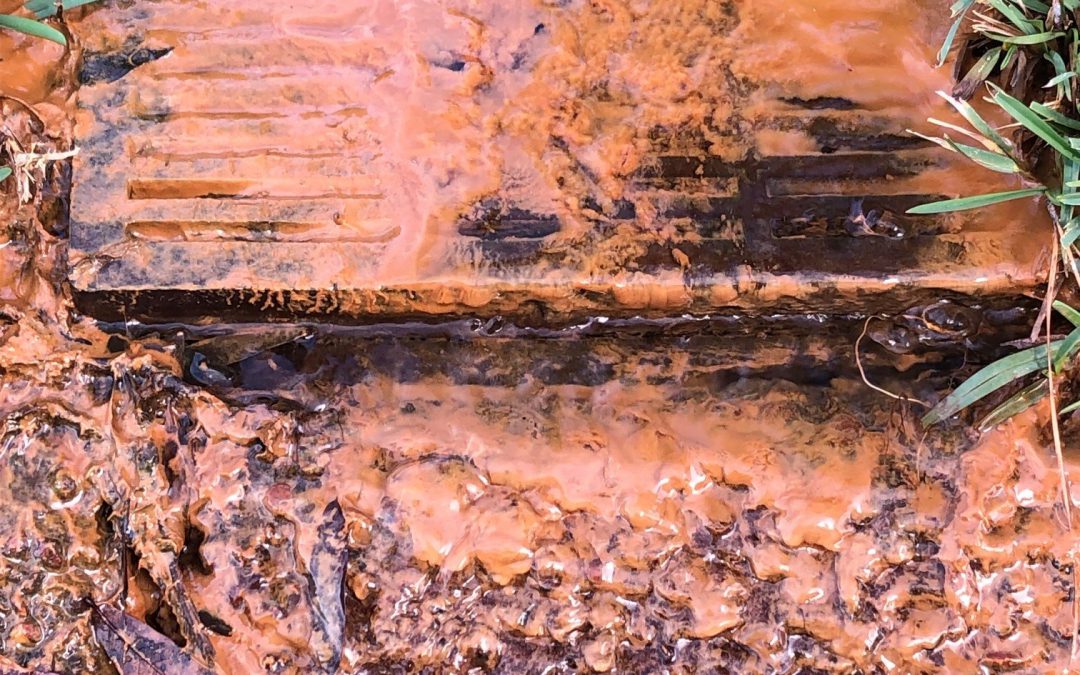
by Carrie Stevenson | Nov 19, 2021
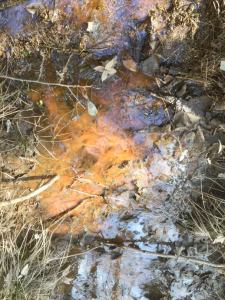
Iron-oxidizing bacteria produces an orange color and oily sheen in the floodplains of Congaree National Park, South Carolina. Used with permission from Karen Jackson, ©2020, Clemson University
“Someone dumped oil in the creek behind my house!” I had dozens of people call with that exclamation when I was a field inspector for the Florida Department of Environmental Protection’s (FDEP) wetlands compliance program. A significant portion of the job entailed responding to concerns and complaints from citizens regarding damage to wetland areas. In the field, I would come across an oily film along creeks in rural, near-pristine conditions in northern Holmes County and in heavily populated neighborhoods in the tourist hot spots of Destin and Panama City. The first time I saw it, I was taken aback. A shiny, rainbow sheen is something you might expect in an oil-soaked parking lot, not a relatively untouched body of water.
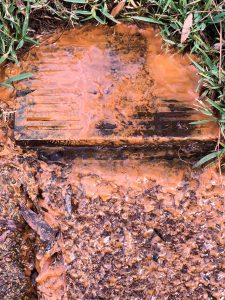
The reaction between iron, native bacteria, and oxygen can produce this orange sheen and filamentous material in streams and groundwater (as it exits the soil). Photo credit: Carrie Stevenson, UF IFAS Extension
Thankfully, an experienced colleague explained the workings of iron-oxidizing bacteria to me, and I was able to allay the fears of all those frantic homeowners. All the places I’ve ever seen evidence of iron bacteria on the water were adjacent to wetlands with some level of iron in the soil. The bacteria essentially “eat” ferrous iron, which is common and able to react with other elements in oxygen-free (anaerobic) environments. Wetlands are classic examples of anaerobic soils, and the mucky conditions of a stream floodplain are ideal for iron bacteria. These are naturally occurring, harmless bacteria that gain energy by breaking down iron available in the soil. In addition to the oily film, side effects of iron-oxidizing bacteria can include a swampy odor, a reddish filament, or red chunks of iron. In large amounts, these byproducts can clog wells if present in pipes. This can be problematic and prevent water flow, but the iron and bacteria are not threats to human health
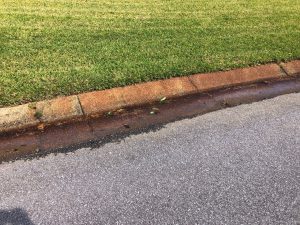 A colleague with Escambia County recently responded to a homeowner call about bright orange water flowing out of their front yard. While not the typical creek location, environmental conditions were absolutely suited for this phenomenon. Their neighborhood is situated adjacent to a large wetland area, and several of the homes have French drains in the backyards that drain out to the street. During heavier rainfalls, excess groundwater enters those pipes, picks up iron bacteria in the soil, and exits to the surface along the road. The red-stained curbs are evidence that iron is common in the local soil.
A colleague with Escambia County recently responded to a homeowner call about bright orange water flowing out of their front yard. While not the typical creek location, environmental conditions were absolutely suited for this phenomenon. Their neighborhood is situated adjacent to a large wetland area, and several of the homes have French drains in the backyards that drain out to the street. During heavier rainfalls, excess groundwater enters those pipes, picks up iron bacteria in the soil, and exits to the surface along the road. The red-stained curbs are evidence that iron is common in the local soil.
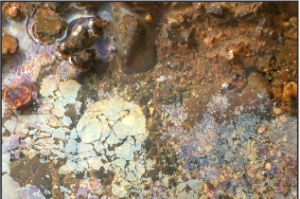
When touched, the sheen produced by iron bacteria will fracture. This is an easy way to differentiate it from actual oil. Photo credit: City of Kirkland, Washington
While it’s possible someone could dump oil in a backwoods area (and if you do ever see that, report it to FDEP), it is much more likely that you are seeing the natural aftereffects of iron-oxidizing bacteria. To determine the difference between iron bacteria and actual oil, one simple test is to touch the water and its oily film with a stick. If the sheen fractures into small pieces, it’s iron bacteria. If it oozes back to an intact slick (and smells like petroleum), it could very well be oil.

by Carrie Stevenson | Oct 21, 2021
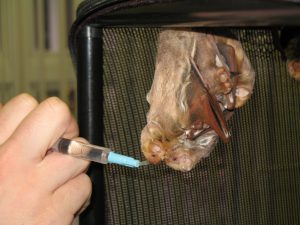
A wildlife biologist feeds an overwhelmed mother bat and her young after they were found on the ground. Photo credit: Carrie Stevenson, UF IFAS Extension
As we enter Halloween season, one of the most popular images of this spooky time of year is that of a bat. The creepy tales of vampire bats and Dracula are enduring and certainly exciting. Unfortunately, many negative connotations exist around this fascinating species. Perhaps you’ve heard they carry rabies, that they will fly into your hair, or that many of them are considered blood-sucking vampire bats?
In fact, there are many benefits to having bats in one’s landscape and neighborhood. The predominant role of bats in our local ecosystem is that of insect predator. A single little brown bat (Myotis lucifugis), which is native to the Florida Panhandle, can eat 1,200 mosquitoes in one hour of feeding! Other species in warmer climates eat fruit and play a major role in reforesting rain forests in Central and South America—after digesting the fruit they leave seeds in their droppings (guano is excellent fertilizer, by the way), helping replant 95% of the very trees they feed upon. Some species feed on nectar, filling the same role as bees and helping pollinate bananas, avocados, cashews, and figs.

Contrary to popular opinion, vampire bats lap up blood from minor cuts on livestock and do not attack or kill them.
Despite the old saying, bats are not blind and many have excellent vision. However, they do rely heavily on echolocation to sense prey and are extremely accurate hunters. They often fly erratically because they are chasing very small flying insects, so the only reason one would end up in a person’s hair is if a mosquito flew through it with a bat in chase! While vampire bats do exist, there are only 3 out of over 1,000 species of bats that feed on blood, and they all live in Latin America. They typically consume blood from livestock by breaking the skin with their teeth and lapping up blood like a cat drinking milk.
Human contact with bats is rare unless the bats are sick, which is why one found on the ground should be left alone. Rabies transmission from bats accounts for only one death per year in the United States—a statistic much less than that of deaths from dog bites, bee stings, and lighting strikes! In fact, several towns in Texas with the highest populations of bats in the country have recorded zero human bat-transmitted rabies cases. If a bat is obviously injured or has pups with it, most wildlife sanctuaries will take them in and give you special instruction on how to approach them.
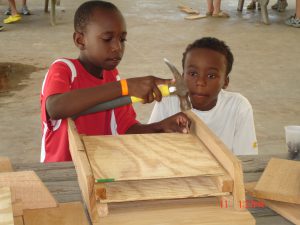
Building bat houses is a great family activity and helps provide much-needed habitat for bats. Photo credit: Carrie Stevenson, UF IFAS Extension
Bat populations are declining in North America due to disease (particularly white-nose syndrome), loss of habitat, and the slow reproductive cycle of bats. However, you can help the world’s only flying mammal by installing a bat house in your yard. Keep in mind that bats attracted to bat houses prefer to be in open areas away from trees (where their predators hide), and the house should be installed at least 12 feet in the air. Bat houses can be purchased or built rather simply—keep an eye out for Extension workshops near you, or visit Bat Conservation International’s website for simple instructions.
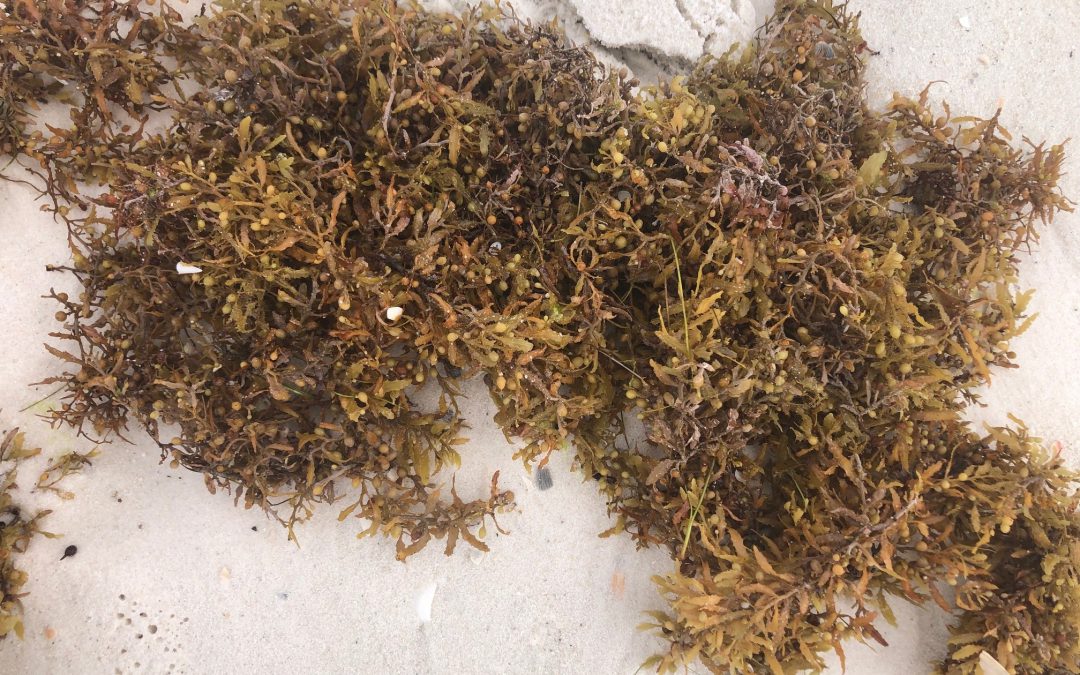
by Carrie Stevenson | Jul 29, 2021
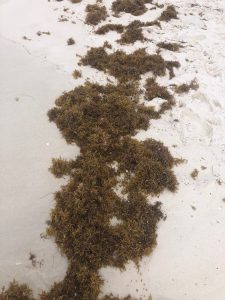
Sargassum washed ashore after a storm on Pensacola Beach. Photo credit: Carrie Stevenson, UF IFAS Extension
I am sure it drives the tourists a little crazy. After daydreaming all year of a week relaxing at the beach, they arrive and find the shores covered in leggy brown seaweed for long stretches. It floats in the shallow water, tickling legs and causing a mild panic—was that a fish? A jellyfish? A shark? Then, of course, high tide washes the seaweed up and strands it at the wrack line, shattering the vision of dreamy white sand beaches.
But for those visitors—and locals—willing to take a closer look, the brown algae known as sargassum is one of the most fascinating organisms in the sea. The next time you are at the beach, pick some up and turn it over in your hands. Sargassum is characterized by its bushy, highly branched stems with numerous leafy blades and berry-like, gas-filled structures. The tiny air sacs serve as flotation devices to keep the algae from sinking. This unique adaptation allows it to fulfill a niche at the top of the water column, instead of growing at the bottom or on another organism.
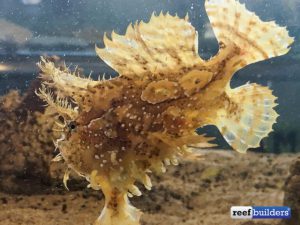
The sargassum fish blends incredibly well into its home within sargassum mats. It uses handlike pectoral fins to move around. Photo credit: Reef Builders
Sargassum tends to accumulate into large mats that drift through the water in response to wind and currents. These drifting mats create a pelagic habitat that attracts up to 70 species of marine animals. Several of these organisms are adapted specifically to life within the sargassum, reaching full growth at miniature sizes and camouflaged in shape, pattern, and color to blend in. These very specialized fauna include the sargassum crab, the sargassum shrimp, sargassum flatworm, sargassum nudibranch, sargassum anemone, and the sargassum fish! The sargassum fish (Histrio histrio) is in the toadfish family, a group of slow-moving reef fish that pick their way through coral and algae by using their pectoral fins like hands. Sea turtle hatchlings will spend their early years feeding and resting within the relative safety of large mid-ocean sargassum mats.
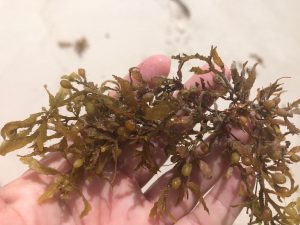
The small air-filled sacs of sargassum allow it to float on the surface, becoming the basis of a teeming ecosystem. Photo credit: Carrie Stevenson, UF IFAS Extension
Over time the air sacs lose buoyancy and the sargassum sinks, providing an important source of food for bottom-dwelling creatures. If washed ashore, many of the animals abandon the sargassum or risk drying out and dying.
In general, most of the larger, familiar seaweeds like sargassum are brown algae. Brown algae (including kelp and rockweed) have colors ranging from brown to brownish yellow-green. These darker colors result from the brown pigment fucoxanthin, which masks the green color of chlorophyll. Extractions from brown algae are commonly used in lotions and even heartburn medication!
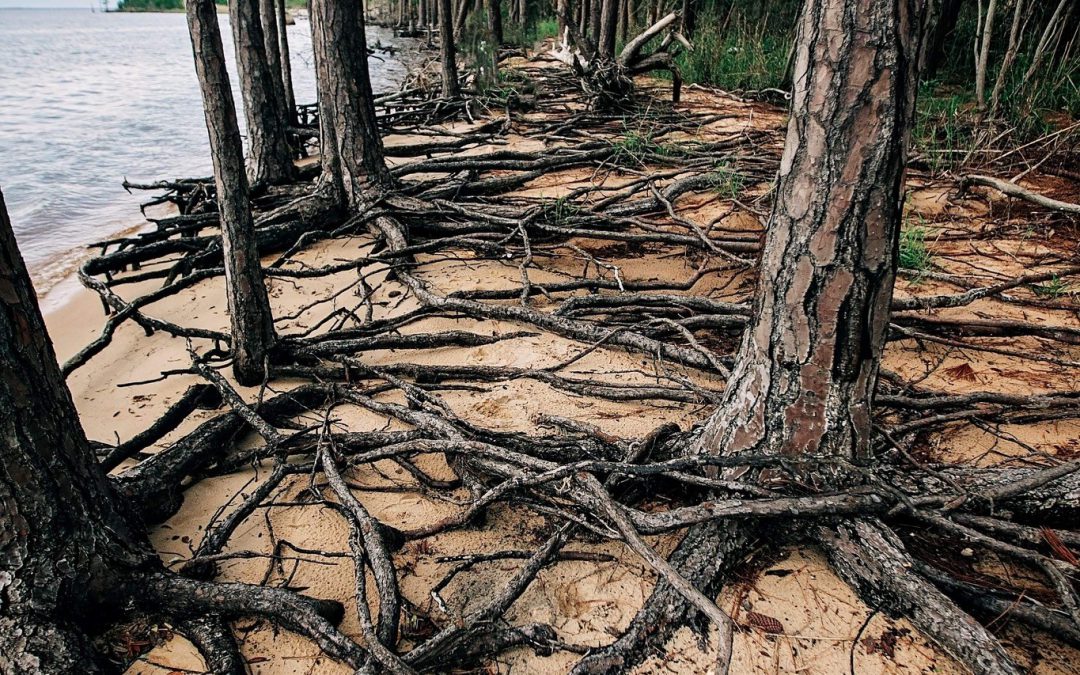
by Carrie Stevenson | May 7, 2021
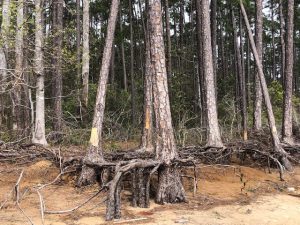
A ghost forest forming along the shoreline of Blackwater Bay in Santa Rosa County. Photo credit: Carrie Stevenson, UF IFAS Extension
As the name implies, they are haunting—wide stretches of standing, dead trees with exposed roots. These “ghost forests” are an unsettling scene in unsettling times for the environment. While coastal erosion is a fact of life—incoming waves, hurricanes, longshore drift of beach sand—the rate of its occurrence is startling lately.
Global rises in sea level due to increased atmospheric carbon levels mean more saltwater is moving into flat, coastal habitats that once served as a buffer from the open water. Salt is an exceedingly difficult compound for plants to handle, and only a few species have evolved mechanisms for tolerating it. Low-growing salt marshes and thick mangrove stands have always served as “first line of defense” buffers to take in wave action and absorb saltwater. If shorelines have too much wave action for marshes to form, wide stretches of sandy beach and dunes serve the same function, protecting the inland species of shrubs and trees. Many coastal areas are flat and stay at or just above sea level for thousands of yards, or even miles. This means that even a small increase in sea level can send saltwater deep into previously freshwater systems, drowning the marsh and flooding stands of oak and pine. The salt and sulfate in seawater will kill a tree quickly, although it may remain standing, dead, for months or years. Hurricanes and tropical storms exacerbate that damage, scouring out chunks of shoreline and knocking down already-unstable trees.

This diagram outlines the changes in coastal vegetation and shorelines as sea level rises. With “ghost forests,” the sea level moves into that coastal forest section. Figure credit: W. Gray, IAN Image Library
A slow increase in sea level could be tolerated and adapted to as salt marshes move inland and replace non-salt tolerant species. But this process of ecological succession can be interrupted if erosion and increased water levels occur too quickly. And if there is hard infrastructure inland of the marshes (like roads or buildings), the system experiences “coastal squeeze,” winnowing the marsh to a thin, eventually nonexistent ribbon, with no natural protection for that expensive infrastructure.
Ghost forests are popping up everywhere. Earlier this month, Popular Mechanics magazine reported on a recently published study that used satellite imagery to document how 11% of a previously healthy forest was converted to standing dead trees along the coast of North Carolina. The trees died within a span of just 35 years (1984-2019). During that time frame, this stretch of coastline also experienced an extended drought and Category 3 Hurricane Irene. These impacts sped up the habitat loss, with over 19,000 hectares converted from forest to marsh and 1100 hectares of marsh vegetation gone, becoming open water.
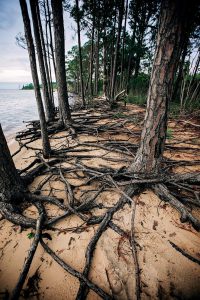
Exposed roots of a ghost forest forming along the Escambia Bay. Photo credit: Deanie Sexton
Due to increased coastal flooding and saltwater standing in forested areas, U.S. Fish and Wildlife Service employees are concerned that the historic Harriett Tubman Byway in Maryland—part of the famed underground railroad of the Civil War era—will soon be gone. Over 5,000 acres of tidal marsh have converted to open water in the area and large stands of trees have died. Even locally, trees along Escambia and Blackwater Bay are dying due to salt damage and heavy erosion. Hurricane Sally delivered a knockout punch to many remaining trees along the scenic bluffs of the bay.
Sea level has risen over 10” in the past 100 years in the Pensacola Bay area, and even mid-range Army Corps of Engineers estimates expect 0.6 to 1.4 feet of rise in the area by 2045. There are some actions we can take to mitigate future damage. Building a “living shoreline” of vegetation along a piece of waterfront property instead of using a seawall can help, especially if the vegetation growth outpaces sea level rise. You can also visit the City of Pensacola’s Climate Task Force report to learn more about climate action recommended (and being taken) locally, such as increasing the use of renewable energy and dedicating staff to sustainability measures.
by Carrie Stevenson | Jan 14, 2021
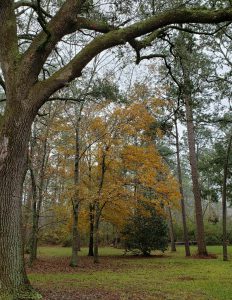
A healthy and diverse native forest provides many benefits for environmental and human health. Photo credit, Cathy Hardin
Trees often are low on priority lists – unless you had tree damage as a result of Hurricane Sally. However, you might be surprised to learn that trees played a beneficial, if somewhat behind the scenes, role for good this year and every year. And celebrating the good, while not ignoring potential problems, is important when making decisions involving trees.
Often trees are disparaged, especially after a severe storm. Many trees fell during Sally, causing costly clean up and often significant damage. Some trees were damaged: causing hazardous conditions, opportunities for the tree disease and insect infestation, or simply aesthetically unpleasant disfigurement. Even without storms, trees require care, can interfere with utilities and foundations, and require extra clean up certain times of year. Yet, healthy well-maintained trees might reduce wind speeds and damage for property underneath or on the leeward (downwind) side of trees. Trees also significantly reduce erosion and absorb stormwater.
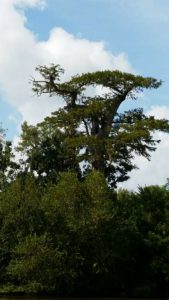
Bald cypress. Photo credit, Cathy Hardin
Trees often give more than they take. Many studies have been done on the effects of green space on a person’s well-being, including lowering blood pressure, speeding up recovery times, and lessening depression and anxiety. Other social benefits include lowering crime rates, increasing property values, creating beauty and space for recreation and relaxation, and lowering cooling bills. They provide habitat for birds and other wildlife. We haven’t even begun to mention the material benefits such as fruit, nuts, wood, and the 5,000 plus commercial products made from trees (wood, roots, leaves, and saps).
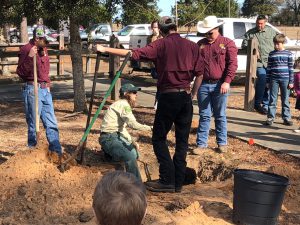
Author and county forester Cathy Hardin demonstrates proper tree planting at a past Arbor Day program. Photo credit: Carrie Stevenson, UF IFAS Extension
So, celebrate trees this year! Winter is a great time to improve existing trees and to plant new ones. Florida Arbor Day is celebrated the on the third Friday in January – January 15, 2021. National Arbor Day is the last Friday in April. In Escambia County, the UF IFAS Extension office is holding several Arbor Day related events, including a drive-through tree giveaway on January 23. Even if you are not able to attend a public event in your area, you still can get out and celebrate trees. Below are some ideas.
Existing Trees
• Care for storm damaged trees.
o Contact an arborist for evaluation of potential hazards
o Properly prune out broken limbs to create a smooth surface
o Some trees may not be able to be successfully treated and need removal
o Most trees will recover, but might need time and/or multiple treatments
• Learn about proper pruning techniques to take care of smaller trees yourself
• When hiring a professional is required, hire a reputable company with a certified arborist on staff. Ensure the company has both Personal and Property Damage Liability Insurance and Worker’s Compensation Insurance. Arborists certified by the International Society of Arboriculture can be found at http://www.isa-arbor.com/findanarborist/arboristsearch.aspx.
• Take care of tree roots. Don’t compact the soil by parking or piling things in the root zone. Use caution
when applying any chemicals (fertilizer, herbicide, pesticides) to the soil or lawn. Read the label to
ensure it will not harm your tree.
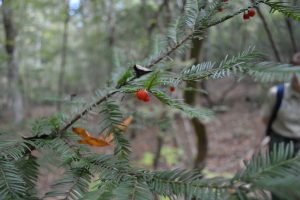
Florida yew. Photo credit, Cathy Hardin
New Plantings
• Decide what species of tree is right for you, considering the soil type, size of opening, climate, and eventual size of tree.
• Plant the tree at the right depth, not too deep or too shallow.
• Keep it simple. Soil amendments, fertilizers, and staking are usually unnecessary, especially for small native trees.
• Mulch lightly over the root zone, but not against the trunk.
• Water regularly until the tree is established. (Three gallons per inch of tree diameter weekly – applied slowly at the root ball)
• Celebrate!
• Take a photo of your favorite tree to post on social media. Tag the Florida Forest Service!
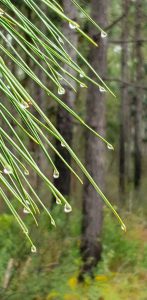
Longleaf pine. Photo credit, Cathy Hardin
• Take a hike in the woods or a nearby park.
• Have a picnic with friends or family by a tree.
• Be grateful for your tree and its benefits.
• Teach a child about trees. There are many activities that can be used. Check out Project Learning Tree Activities for Families – Project Learning Tree (plt.org) or the Arbor Day Foundation www.ArborDay.org for a few ideas.
• Plant a new tree.
For more information on the benefits of trees, visit healthytreeshealthylives.org or www.vibrantcitieslab.com. The Florida Forest Service, a division of the Florida Department of Agriculture and Consumer Services, manages more than 1 million acres of state forests and provides forest management assistance on more than 17 million acres of private and community forests. The Florida Forest Service is also responsible for protecting homes, forestland and natural resources from the devastating effects wildfire on more than 26 million acres. Learn more at FDACS.gov/FLForestService.
Cathy Hardin is the Escambia County Forester for the Florida Forest Service and can be reached at Cathy.Hardin@fdacs.gov.



 A colleague with Escambia County recently responded to a homeowner call about bright orange water flowing out of their front yard. While not the typical creek location, environmental conditions were absolutely suited for this phenomenon. Their neighborhood is situated adjacent to a large wetland area, and several of the homes have French drains in the backyards that drain out to the street. During heavier rainfalls, excess groundwater enters those pipes, picks up iron bacteria in the soil, and exits to the surface along the road. The red-stained curbs are evidence that iron is common in the local soil.
A colleague with Escambia County recently responded to a homeowner call about bright orange water flowing out of their front yard. While not the typical creek location, environmental conditions were absolutely suited for this phenomenon. Their neighborhood is situated adjacent to a large wetland area, and several of the homes have French drains in the backyards that drain out to the street. During heavier rainfalls, excess groundwater enters those pipes, picks up iron bacteria in the soil, and exits to the surface along the road. The red-stained curbs are evidence that iron is common in the local soil.

















